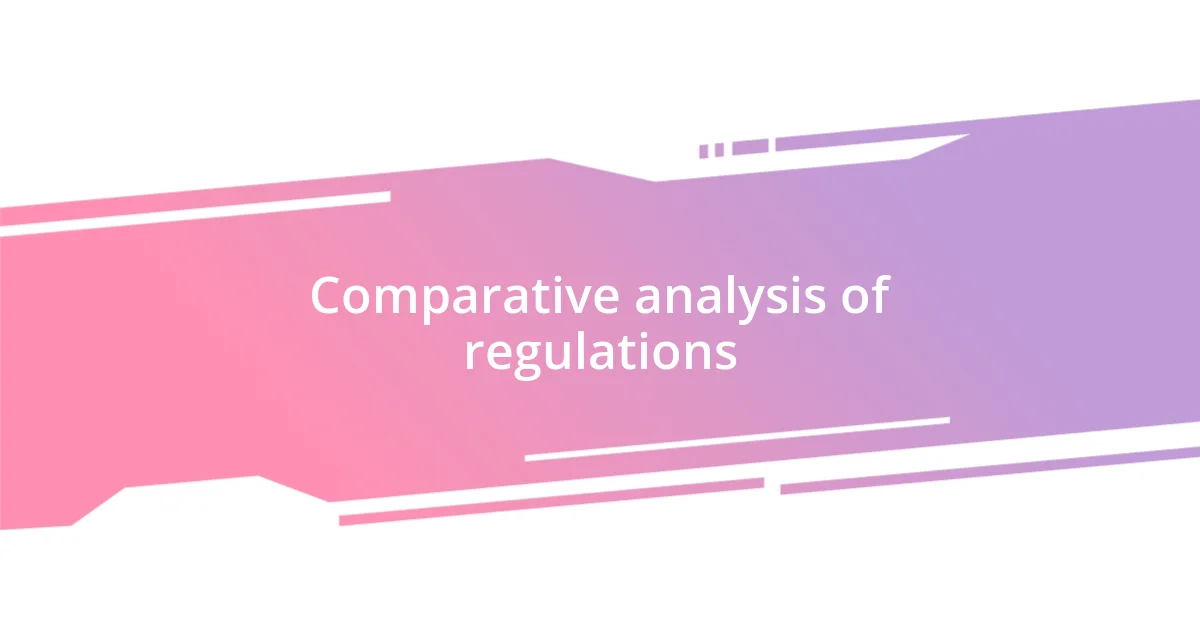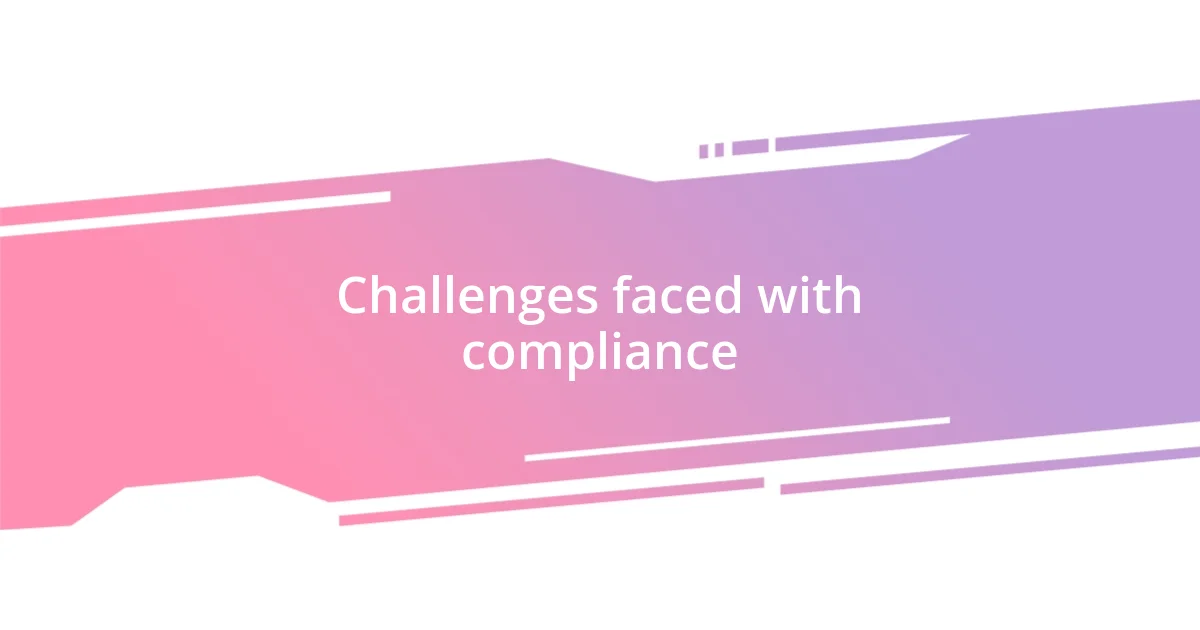Key takeaways:
- The variability in international crypto regulations can significantly impact innovation and market dynamics, with countries like Japan fostering growth while others, like China, impose strict bans.
- Engaging with local regulators and staying informed through continuous education and networking are crucial best practices for navigating the complex regulatory landscape.
- Future trends indicate a move towards global harmonization of regulations, dynamic adaptations to new technologies, and a focus on consumer protection and sustainability in the crypto space.

Understanding international crypto regulations
Understanding international crypto regulations can often feel like navigating a maze. I remember my first encounter with varying rules in different countries; it was overwhelming. For instance, when I tried to trade cryptocurrencies during my travels, I quickly realized that what was legal in one country might land you in hot water in another. Isn’t it astonishing how one technology can be subject to such disparate rules?
The complexity of these regulations can evoke a sense of unease. As I delved deeper into the topic, I discovered countries like Japan, which embraces crypto with open arms, versus others that impose strict bans. Think about it: how does this inconsistency affect the global market? It made me reflect on how regulations can inhibit or fuel innovation. Some regions foster growth, while others can stifle it.
Moreover, the ever-changing landscape of international crypto regulations means continuous learning and adaptation. I often find myself checking the latest news to stay compliant, as what was true yesterday might not hold today. Have you felt that pressure? Adapting to these regulations is an ongoing journey, and it’s fascinating to witness how they evolve alongside technologies like blockchain.

My journey into crypto regulations
My journey into crypto regulations has been quite a rollercoaster ride. I distinctly remember the first time I tried to navigate these rules while setting up a crypto wallet in Europe. I was excited, but that excitement quickly turned into confusion as I encountered different regulations in each country I visited. It was eye-opening to see how something so revolutionary can have such varied rules, often hinging on historical perspectives of finance and technology.
Then, there was a moment during a conference where I met a fellow enthusiast from India. He shared his experience of launching a crypto project amidst regulatory uncertainty, battling with government stances that seemed to shift weekly. Hearing his story struck a chord with me; it was a vivid reminder of how these regulations aren’t just technicalities—they impact real people and their innovative ideas. Doesn’t it make you think about the potential that could be unleashed with clearer guidelines?
As I continued my exploration, I found that keeping up with these regulations felt like a never-ending quest. I often recall a particularly late night when I was reviewing updates on legal frameworks, and the fatigue hit me. But then, a sense of determination kicked in, understanding that staying informed was part of playing in this fascinating arena. How do you stay motivated in the midst of all this complexity? For me, it’s the thrill of innovation and the potential for global connectivity that keeps me engaged.
| Country | Regulation Type |
|---|---|
| Japan | Favorable, progressive legislation |
| India | Uncertain, fluctuating policies |
| United States | Varied by state, complex legal framework |
| China | Strict bans on trading |
| European Union | Developing regulations, mixed approaches |

Key regulatory frameworks worldwide
Navigating the world of international crypto regulations has opened my eyes to the fascinating contrasts between different jurisdictions. I recall the first time I tried to explain the U.S. regulatory landscape to a friend. I threw my hands up in frustration, exclaiming that what you encounter depends not just on federal guidelines but also on varying state laws. It struck me how this patchwork system could be both a breeding ground for innovation and a quagmire for entrepreneurs.
Here are some key regulatory frameworks I’ve come across:
- Japan: A pioneer in regulation, fostering a supportive environment for cryptocurrencies.
- India: A land of uncertainty; innovators often hold their breath waiting for policy updates.
- United States: A jigsaw puzzle, where state-by-state differences can lead to confusion or opportunity.
- China: An outright ban on trading, leaving many to wonder about the long-term implications for Chinese crypto enthusiasts.
- European Union: Currently evolving regulations with varying degrees of acceptance among member states.
One experience that stands out for me is at a startup meetup in Berlin, where the diverse global perspectives on regulations were palpable. Each pitch resonated with the hopes and challenges of operating within an ambiguous regulatory framework. The excitement in the room was real, but so was the anxiety. I could feel it—everyone was aware that legislation could pave or obstruct their paths. When I left that evening, the buzzing conversation about how regulations could transform the landscape lingered in my mind, reinforcing my belief that understanding these frameworks is crucial for anyone looking to thrive in this space.

Comparative analysis of regulations
In my observations, Japan stands out for its proactive approach to crypto regulation. During my visit, I had a chance to chat with a local entrepreneur who emphasized how helpful the regulatory clarity was for their business. It was refreshing to see a country embrace innovation while ensuring investor protection. Isn’t it inspiring when regulations align with the tech community’s vision?
In stark contrast, my discussions with startups in India revealed a palpable sense of anxiety over fluctuating policies. One young developer shared how he almost shelved his project because the guidelines seemed to change overnight, leaving many in limbo. How often do people have to pause their dreams due to uncertain regulations? It’s a reality that too many face, and it makes you wonder about the potential breakthroughs waiting to be unleashed if only there was stability.
Then there’s the European Union, where the regulatory landscape feels like a patchwork quilt. Each member state has its take, leading to and fro around innovation and compliance. I remember meeting a tech investor who candidly admitted that deciphering which regulations applied to their potential investments was like solving a puzzle. It struck me—how many opportunities are lost in translation? This diversity often creates both challenges and unique opportunities for crypto advocates aiming to bridge gaps across nations.

Challenges faced with compliance
Compliance with international crypto regulations can feel like navigating a maze, filled with unexpected turns and dead ends. In my journey, one challenge that consistently stands out is the lack of uniformity between jurisdictions. While attending a conference in Singapore, I spoke to an entrepreneur frustrated by the stark differences between Southeast Asian regulations. It made me wonder: how can businesses adapt when rules seem to shift like sand beneath their feet? The constant need to stay updated can be overwhelming and can stifle innovation.
I’ve noticed that the varying levels of regulatory maturity also complicate compliance. For instance, while in Switzerland, I was impressed by how straightforward and supportive the local laws were. However, turning to other regions, like Brazil, I heard from developers struggling to make sense of contradictory regulations that seemed to change daily. This disparity sparked a thought: what happens to emerging projects that lack resources to keep pace with such rapid changes? It’s not just about compliance; it’s about survival in an unpredictable landscape.
Then there’s the emotional toll compliance takes on entrepreneurs. During a late-night brainstorming session in London, I could see the weariness in my peers’ faces, each grappling with the stress of potential fines or operational shutdowns. One of them shared a story about losing a significant investor simply due to regulatory uncertainty. It left me questioning how many dreams are dashed because of a lack of clear, consistent guidance. Compliance shouldn’t feel like a minefield; it should empower innovation, not hinder it.

Best practices for navigating regulations
Navigating international crypto regulations requires a proactive approach and a solid understanding of local laws. I remember sitting down with a compliance officer in Malta, where I learned the importance of building relationships with local regulators. This connection helped her company stay ahead of emerging regulations. Have you considered how networking could aid in your own compliance journey?
Another key practice is to invest in comprehensive education. On a recent trip to Berlin, I attended a workshop where industry leaders shared their insights on compliance strategies. It struck me how critical it is to equip yourself and your team with the knowledge to adapt. Wouldn’t you agree that staying informed not only reduces risks but also fosters a culture of innovation within your organization?
Finally, I’ve found that leveraging technology can streamline compliance processes. While exploring a fintech hub in Toronto, I encountered tools specifically designed for tracking regulatory changes. It was a game changer for the startups I met, enabling them to focus on growth while minimizing the compliance burden. Can you imagine how much more productive teams could be if they spent less time worrying about regulations and more time innovating?

Future trends in crypto regulation
As I look ahead, one noticeable trend in crypto regulation is the growing push for global harmonization. I recently connected with a regulatory expert in Amsterdam who highlighted how international organizations are increasingly collaborating to create unified frameworks. It made me think about how much smoother compliance could be for businesses if there were standardized rules across borders. Wouldn’t that simplify the lives of countless entrepreneurs?
I’m also sensing a shift towards more dynamic regulatory environments, where rules adapt quickly to technological advancements. During a recent chat with developers in Singapore, they expressed hope that regulators would embrace innovative technologies like DeFi and NFTs rather than stifling them with outdated regulations. It’s fascinating to envision a future where regulations evolve alongside the industry, fostering rather than hindering innovation.
Moreover, I believe we will see a greater emphasis on consumer protection and environmental sustainability in upcoming regulations. After a panel discussion in Berlin on the impact of energy consumption in crypto, I was struck by how passionate the audience was about creating a sustainable future. If regulators align with public sentiment, it could usher in an era where responsible practices are not only encouraged but mandated. How might this shift affect the way we design and operate crypto projects going forward?














